Toronto Fire Services
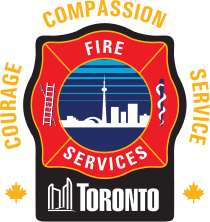 | |
| "Courage, Compassion, Service" | |
| Operational area | |
|---|---|
| Country | Canada |
| Agency overview | |
| Established | 1874 (as Toronto Fire Department), 1998 (as Toronto Fire Services) |
| Annual calls | 111,758 (2014) |
| Employees | 3,100 |
| Staffing | Career |
| Fire chief | Matt Pegg (Interim) |
| EMS level | BLS First Responder |
| Facilities and equipment | |
| Stations | 82 |
| Engines | 83 (55 pumpers/28 rescue-pumpers) |
| Quints | 30 |
| Tenders | 1 |
| HAZMAT | 2 |
| USAR | 1 |
| Fireboats | 2 |
The Toronto Fire Services (TFS) provides fire protection and first responder or emergency medical responder assistance to the city of Toronto, Ontario, Canada. The Toronto Fire Services is currently the largest municipal fire department in Canada.
Overview
The Toronto Fire Services was created in 1998 from the merger of the former fire departments of the original City of Toronto, East York, Etobicoke, North York, Scarborough and York. It is the largest fire department in Canada (ahead of Montreal, Vancouver and Ottawa) and the 5th largest municipal fire department in North America behind New York City, Chicago, Houston, and Los Angeles.
History

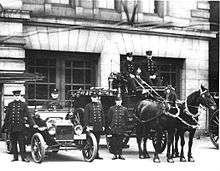
Fire services in Toronto began in 1874 in the former City of Toronto, and still consisted of volunteer fire companies. Prior to 1874, fire services were composed of poorly trained volunteer companies in the city. The first company was created in 1826 and hook and ladder in 1831. Most were able bodied men who were trained to operate pumps to draw water from the lake.
The city's poor fire fighting services were highlighted by the Great Toronto Fire in 1849 and again in 1904. After the latter fire, which destroyed much of Bay Street from The Esplanade West to Melinda Street, the Fire Department in Toronto became a critical city service and has evolved into the professional service that exists today.
Early fire companies
- 1st Engine 1826 at Church Street and Newgate Street (Adelaide Street East), renumbered as Station 5 in 1861 and closed in 1874
- Independent Fire Company Engine House No. 2
- York Fire Company 1826 at Fireman's Hall (Church Street and Newgate Street)
- Hook and Ladder Fire Company 1831
- Fireman's Hall 1839 at Bay Street 1839; closed 1841
- Station No. 1 1841; closed 1924
- 4th Engine House at St. Patrick Market on Queen Street West 1842, closed 1861
- Hose Company No. 2 at Berkeley Street 1849; closed 1859
- 7th Engine Company at Elizabeth Street 1857; closed 1859
- Station No 2 at 163 Portland 1871; closed 1968
- Station No 3 at 488 Yonge Street 1871; closed 1926
- Station No 5 at Court Street 1874; closed 1886
- Station No 6 at 315 Queen Street West 1874; closed 1942
Township Fire Departments
- Scarborough Fire Department 1925 - replaced 5 volunteer bucket brigades 1850's[1]
- North York Fire Department 1923 - merged 7 separate volunteer brigades[2]
- New Toronto Fire Department 1930 - merged with Etobicoke FD 1967[3]
Organization
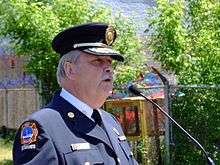
The Fire Chief (C1), under whom serve five deputy Chiefs (C2, C3, C4, C5, C50), and four division commanders (C6, C7, C8, C9) - all based at 4330 Dufferin Street, the central headquarters for both Toronto Fire and Toronto Paramedic Services (former headquarters for TEMS and Metro Toronto Ambulance). Former Chief Bill Stewart's retirement was announced on February 13, 2012 and took effect on April 30, 2012. Sales is a former Markham Fire Chief who also worked as a political bureaucrat in Town of Markham and as General Manager with the City of Barrie prior to his appointment.[4]
The Chief's position is being held by Deputy Chief Matthew Pegg as Interim Chief following the departure of Jim Sales.[5]
Previous Chiefs
With the exception of Sales, Toronto Fire Services and Toronto Fire Department Chiefs have been promoted within the department's ranks.
- Jim W. Sales 2012-2016
- William A. Stewart 2003–2012
- Alan F. Speed 1997–2003
- Peter L Ferguson 1995-1998
- Walter Shanahan 1988–1995, Toronto Fire Department
- Bernard (Ben) Bonser 1977–1988
Rank Structure
| RANK | Chief of Department | Deputy Fire Chief | Division Commander | Platoon Chief | District Chief | Captain | First Class Firefighter | Second Class Firefighter | Probationary Firefighter |
|---|---|---|---|---|---|---|---|---|---|
| INSIGNIA |  |
 |
 |
 |
 |
 |
No Insignia | No Insignia | No Insignia |
| HELMET COLOUR | White | White | Red | Black | Black | Black | |||
| DESCRIPTION | Command officer responsible for all four shifts within one of the geographic divisions (North, East, South, or West) of the city | Command officer responsible for all fire stations within all four districts of a command for one shift (North, East, South, or West) | Command officer responsible for all fire stations within a district (ex. 11 District, or 42 District). | Company Officer in charge of one fire truck and crew. | |||||
| NOTES | "Chief" marked on the back of his or her bunker jacket. | "Deputy Chief" marked on the back of his or her bunker jacket | 'Division Commander' marked on the back of his or her bunker jacket. | "Platoon Chief" marked on the back of his or her bunker jacket | "District Chief" marked on the back of his or her bunker jacket. |


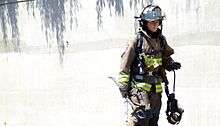
Operations
Fire Apparatus

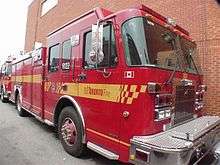
Toronto Fire Department began using motorized vehicles after 1910. Before that, the TFD and previous fire companies used horse drawn engines and ladders. Prior to the 1970s, the TFD had open air vehicles (driver cab not covered and mostly aerial trucks), but since then both the TFD and TFS use full covered vehicles. Prior to the 1950s, TFD used tiller-ladder trucks and since have reverted to smaller aerial units that can operate in narrow streets in Toronto.
The TFS inherited all the vehicles of the fire departments prior to amalgamation. The current strength of TFS consists of 179 vehicles. Since amalgamation, apparatus numbers are numbered by a letter and 3 digits. The first digit stands for the command that the apparatus is in (1-North, 2-East, 3-South, 4-West). The second digit stands for the district within the command that the apparatus is in. The last digit stands for the station within the district within the command that the apparatus is assigned to.
A list of types of vehicles used by the TFS : (prefix letter in brackets with x's as placeholders)
- Aerial (Axxx) - most common ladders found in the city; lengths range from 75 to 105 feet (22.86 to 32 metres)
- Tower (Txxx) - 2 articulated boom ladders, with 1 found in South and 1 in North Command; length 114 feet (34.75 metres); T331 is now a spare
- Platform (PLxxx) - 1 ladder with attached platform, found in West Command; length 100 feet (30.48 metres)
- Pumper (Pxxx)
- Rescue (Rescue Pumper) (Rxxx) - a pumper with the addition of extrication equipment (Jaws of Life) and other tools
- Fireboat (FBxxx) - 2 units, both stationed in Toronto Harbour
- Hazardous Materials Unit (HZxxx) - 1 in both North and South Commands
- Hazmat Support Unit (HSxxx) - Unmanned equipment vehicle
- Decontamination Unit (DExxx)
- Squad (Sxxx) - heavy/technical rescue units, with 2 located in South Command and 1 in each of West, North, and East Commands
- High Rise Unit (HRxxx) - 1 only, in South Command
- Water Tanker (WTxxx) - 1 only, in East Command
- Rapid Attack Vehicle - (Van335)
- All-Terrain Vehicle (ATVx) - used at special events, such as the Canadian National Exhibition
- Trench Rescue Support Truck (TRSxxx) - 1 only, in East Command
- Air/Light Unit (LAxxx) - 1 in each Command (A/L 114, A/L 231, A/L 333, A/L 421)
- District Chief (Cxx)
- Platoon Chief (Cx0) - 1 in each Command (C10, C20, C30, C40)
- Division Commander (Cx)
- Deputy Chief / Fire Chief (Cx)
- Command Truck (CMDxx) - 3 throughout the city
- Mechanical Response Unit (MRUxxx)
- Training Aerial (TRAx) - used by Professional Development and Training
- Training Pumper (TRPx) - used by Professional Development and Training
- Spare vehicles (X5xxx) - non-permanent additional vehicles added to station
Fire Boats


The Toronto Fire Department and successor Toronto Fire Services has operated fire boats since 1923.
- Fireboat "Charles A. Reed" - a wood hull boat entered service in 1923 and remained in use until 1964[6]
- Fireboat "William Lyon Mackenzie" - entered service in 1964 replacing Charles A. Reed; main fire boat and icebreaker
- Fireboat "Sora" - light utility boat built in 1982 for the Canadian Coast Guard and acquired by TFS in 2006; back up to WL Mackenzie, but lacks icebreaking features. The Sora was retired from TFS on October 31, 2015.
- Fireboat "William Thornton" - Mid-shore patrol built in 1982 for CCG and acquired by TFS in 2015; has replaced the Sora
Miscellaneous Units
While not part of the fleet, Box 12 (Box 12 Association) and Support 7 (Greater Toronto Multiple Alarm Association) are canteen trucks run by volunteers and are present at large emergencies to provide food and beverages for Toronto firefighters. Formed in 1975, the GTMAA vehicles are painted with TFS scheme, but not the logo (using the GTMAA patch instead).
In addition, there are various Hazardous Materials Support trucks and a Trench Rescue Support truck that respond to specialized calls. These trucks are unmanned, and are only used by trained personnel when a specialized call is dispatched. TFS also has a fleet of various mechanical support trucks. Smaller compact cars bearing the TFS colours and logo are driven by fire prevention officers and other commanding officers.
Toronto Fire will also acquire use of the Long Range Acoustic Device. It was one of three purchased by the Toronto Police Service for use during the G20 summit in 2010 (1 for Marine Unit, 2 for Public Safety Unit).[7]
Prior to amalgamation, the Scarborough Fire Department had their fleet painted yellow. In the years following amalgamation the markings on the fire trucks were a patchwork of the various schemes used by the former boroughs. All had "Toronto" decaled or painted where the former borough's name used to be and the new Toronto Fire crest was added with the new numbering scheme. Over the past 12 years - post amalgamation - the majority of the older vehicles have either been retired or repainted to match the new scheme: fire engine red with yellow reflective trim and markings.
Fire Stations/Apparatus
The Toronto Fire Services (TFS) currently operates out of 83 Fire Stations (including one open seasonally) throughout the city, organized into 16 Districts. Each District is part of one of four geographical divisions of Command. Each geographical division is divided into four Districts.[8][9]
North Command
The North Command's Office (Command 1) is located at Fire Station # 116, 1 Ester Shiner Blvd
District 11
| Station # | Station Address | Apparatus/Callsigns |
|---|---|---|
| 111 | 3200 Bayview Ave. | P111, C11 |
| 112 | 5700 Bathurst St. | R112 |
| 113 | 700 Seneca Hill Dr. | P113, A113 |
| 114 | 12 Canterbury Pl. | P114, T114, LA114, CMD10, PC10 |
| 115 | 115 Parkway Forest Dr. | R115 |
| 116 | 1 Esther Shiner Blvd. | P116 |
| 121 | 10 William Carson Crst. | P121 |
| 122 | 2545 Bayview Ave. | R122 |
District 13
| Station # | Station Address | Apparatus/Callsigns |
|---|---|---|
| 123 | 143 Bond Ave. | P123 |
| 125 | 1109 Leslie St. | P125 |
| 131 | 3135 Yonge St. | P131, A131 |
| 132 | 476 Lawrence Ave. W. | P132, C13 |
| 133 | 1505 Lawrence Ave. W. | R133, A133 |
| 134 | 16 Montgomery Ave. | R134 |
| 135 | 641 Eglinton Ave. W. | P135 |
District 14
| Station # | Station Address | Apparatus/Callsigns |
|---|---|---|
| 141 | 4100 Keeley St. | P141 |
| 142 | 2753 Jane St. | P142, A142, C14 |
| 143 | 1109 Sheppard Ave. W. | P143, S143 |
| 145 | 20 Beffort Rd. | P145, HAZ145, HS145 |
| 146 | 2220 Jane St. | P146 |
East Command
The East Command's Office (Command 2) is located at Station 221.
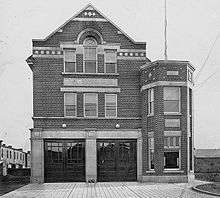
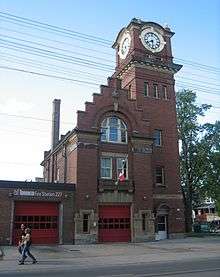
District 21
| Station # | Station Address | Apparatus/Callsigns |
|---|---|---|
| 211 | 900 Tapscott Rd. | P211, TK211 |
| 212 | 8500 Sheppard Ave. E. | P212, C21 |
| 213 | 7 Lapsley Rd. | A213 |
| 214 | 745 Meadowvale Rd. | R214 |
| 215 | 5318 Lawrence Ave. | A215 |
District 22
| Station # | Station Address | Apparatus/Callsigns |
|---|---|---|
| 221 | 2575 Eglinton Ave. | P221 |
| 222 | 755 Warden Ave. | P222, A222 |
| 223 | 116 Dorset Rd. | P223, SUP7 |
| 224 | 1313 Woodbine Ave. | R224 |
| 225 | 3600 Danforth Ave. | R225, C22 |
| 226 | 87 Main St. | P226, A226 |
| 227 | 1904 Queen St. E. | P227 |
District 23
| Station # | Station Address | Apparatus/Callsigns |
|---|---|---|
| 231 | 740 Markham Rd. | R231, A231, LA231, C23, PC20 |
| 232 | 1550 Midland Rd. | P232, S232 |
| 233 | 59 Curlew Dr. | P233 |
| 234 | 40 Coronation Dr. | P234, DE234 |
| 235 | 200 Bermondsey Rd. | R235, TRS235 |
District 24
| Station # | Station Address | Apparatus/Callsigns |
|---|---|---|
| 241 | 3325 Warden Ave. | R241 |
| 242 | 2733 Brimley Rd. | P242, C24 |
| 243 | 4560 Sheppard Ave. | R243 |
| 244 | 2340 Birchmount Rd. | P244, A244 |
| 245 | 1600 Birchmount Rd. | P245 |
South Command
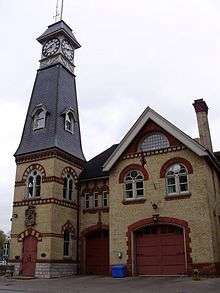
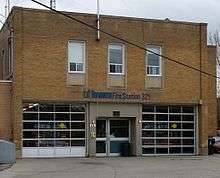
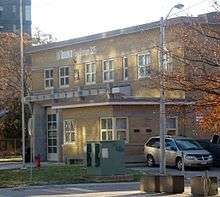
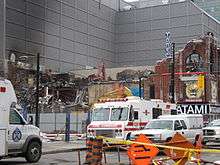

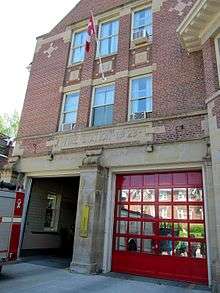
The South Command's Office (Command 3) is located at Fire Station # 332, 260 Adelaide St. W.
District 31
| Station # | Station Address | Apparatus/Callsigns |
|---|---|---|
| 311 | 20 Balmoral Ave. | P311 |
| 312 | 34 Yorkville Ave. | P312, A312, C31 |
| 313 | 441 Bloor St. E. | P313, S313 |
| 314 | 12 Grosvenor St. | P314 |
| 315 | 132 Bellevue Ave. | P315, A315 |
District 32
| Station # | Station Address | Apparatus/Callsigns |
|---|---|---|
| 321 | 231 McRae Dr. | R321, A321 |
| 322 | 256 Cosburn Ave. | P322, A322 |
| 323 | 153 Chatham Ave. | P323, C32 |
| 324 | 840 Gerrard St. E. | P324, A324 |
| 325 | 475 Dundas St. E. | P325, R325, A325 |
| 326 | 30 Knox Ave. | R326 |
District 33
| Station # | Station Address | Apparatus/Callsigns |
|---|---|---|
| 331 | 33 Claremont St. | P331, A331, S331 |
| 332 | 260 Adelaide St. W. | P332, HR332, HAZ332, HMS332, DC33, PC30, CMD30 |
| 333 | 207 Front St. E. | P333, T333, LA333 |
| 334 | 339 Queens Quay. W. | P334, FB334 |
| 335 | 235 Cibola Ave, Toronto Island | P335, V335 |
District 34
| Station # | Station Address | Apparatus/Callsigns |
|---|---|---|
| 341 | 555 Oakwood Ave. | R341, A341 |
| 342 | 106 Ascot Ave. | P342 |
| 343 | 65 Hendrick Ave. | P343 |
| 344 | 240 Howland Ave. | P344 |
| 345 | 1285 Dufferin St. | R345, A345, C34, BOX12 |
| 346 | Canadian National Exhibition | P346 (Seasonal) |
West Command

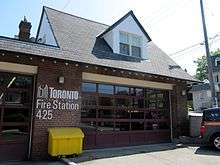
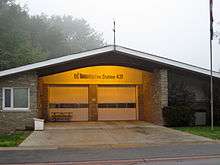
The West Command's Office (Command 4) is located at Fire Station # 442, 2015 Lawrence Ave. W.
District 41
| Station # | Station Address | Apparatus/Callsigns |
|---|---|---|
| 411 | 75 Toryork Dr. | R411, A411 |
| 412 | 267 Humberline Dr. | R412 |
| 413 | 1549 Albion Rd. | R413 |
| 415 | 2120 Kipling Ave. | P415, A415, C41 |
District 42
| Station # | Station Address | Apparatus/Callsigns |
|---|---|---|
| 421 | 6 Lambton Ave. | R421, A421, LA421 |
| 422 | 590 Jane St. | P422 |
| 423 | 358 Keele St. | R423, A423, C42 |
| 425 | 83 Deforest Rd. | R425 |
| 426 | 140 Lansdowne Ave. | P426, R426, A426 |
District 43
| Station # | Station Address | Apparatus/Callsigns |
|---|---|---|
| 431 | 308 Prince Edward Dr. | P431 |
| 432 | 155 The East Mall | P432, PL432, C43 |
| 433 | 615 Royal York Rd. | P433, A433 |
| 434 | 3 Lunness Ave. | R434 |
| 435 | 130 Eighth St. | R435 |
District 44
| Station # | Station Address | Apparatus/Callsigns |
|---|---|---|
| 441 | 947 Martin Grove Rd. | R441, A441 |
| 442 | 2015 Lawrence Ave. W. | P442 |
| 443 | 1724 Islington Ave. | P443 |
| 444 | 666 Renforth Dr. | R444 |
| 445 | 280 Burnhathorpe Rd. | P445, S445, C44, PC40 |
Apparatus Glossary
- Pumper (P) - Standard pumper truck
- Rescue (R) - Rescue pumper truck
- Aerial (A) - Standard rear-mount ladder, often a quint
- Tower (T) - Articulating platform ladder quint
- Platform (PL) - Standard rear-mount ladder quint w. attached platform
- Squad (S) - Technical heavy rescue
- High Rise (HR) - High rise incident truck
- Hazmat (HAZ) - Hazardous Incident Team
- Fire Boat (FB)
- Command Vehicle (CMD) - Walk-in command van
- District Chief (C) - District Chief SUV
- Platoon Chief (PC) - Platoon Chief SUV
- Air/Light (LA) - Air/Light support vehicle
- Trench Rescue Support (TRS) - Trench Rescue support vehicle
- Hazmat Support (HMS) - Hazardous Incident Team support vehicle
- Canteen Vehicle (SUP7) - Long-term incident refreshment van
- Canteen Vehicle (BOX12) - Long-term incident refreshment van
- Decontamination (DE)
Communications
Response Guidelines



Structure/Building Fires
| Alarm Type | Alarm Level | Units Assigned |
|---|---|---|
| Structure Fire | 1st Alarm Assignment | 1 Squad/Rescue, 3 Pumpers/Rescues, 1 Aerial/Tower, 1 District Chief, High Rise Unit(if in High Rise Building in South Command) |
| Working Fire | 1st Alarm Assignment, *Upgrade* | 1 Rescue (R.I.T.), 1 Aerial/Tower, 1 Squad/Rescue, 1 Platoon Chief, 1 Air & Light Unit |
| 2nd Alarm Fire | 2nd Alarm Assignment, *Upgrade* | 1 Rescue (R.I.T) 3 Pumpers/Rescues, 1 Aerial/Tower, 1 Squad, 1 District Chief, 1 Platoon Chief, 1 Haz-Mat. Unit, 1 Air & Light Unit, 1 Command Unit |
| 3rd Alarm Fire | 3rd Alarm Assignment, *Upgrade* | 3 Pumpers/Rescues, 1 Aerial/Tower, 1 District Chief, 1 Tower, 1 Tower Support |
| 4th Alarm Fire | 4th Alarm Assignment, *Upgrade* | 3 Pumpers/Rescues, 1 Aerial/Tower, 1 District Chief, 1 Air & Lighting Unit, 1 Platoon Chief (Comms) |
| 5th Alarm Fire | 5th Alarm Assignment, *Upgrade* | 3 Pumpers/Rescues, 1 Aerial/Tower, 1 District Chief |
Gear
- Starfield Lion Flame Fighter - current bunker gear
- Traditional Composite Firefighting Helmet
Budget Cuts, Vehicle Reduction, Station Closure
As part of the City's 2013 Budget plans, the City of Toronto demanded a 10% cut by all city departments. TFS has recommended vehicle reduction at several stations (Stations 213, 215, 324 and 413) and one station to close (Station 424) to meet the 10% reduction target.[10] As well the cuts will lead to fewer firefighters on staff.[10]
In 2014, 4 pumpers (P213, P215, P413, P424) were taken out of service and Station 424 was shut down.
See also
- List of historic Toronto fire stations
- Service de sécurité incendie de Montréal
- Woodbine Building Supply arson
Other members of the Toronto's Emergency Services structure consists of:
Other agencies with historic ties to the TFD and TFS:
References
- ↑ "History". scarboroughfirefighters.org. Retrieved May 3, 2014.
- ↑ "North York F.D. Information". northyorkfire.org. Retrieved May 3, 2014.
- ↑ "New Toronto Fire Department". newtorontohistorical.com. Retrieved May 3, 2014.
- ↑ Doolittle, Robyn (July 12, 2012). "Toronto's new fire chief a top bureaucrat from Barrie". The Toronto Star. Retrieved July 13, 2012.
- ↑ http://www.citynews.ca/2016/10/07/toronto-fire-chief-jim-sales-departs-role/
- ↑ Discover & explore Toronto's waterfront, Mike Filey, pp34
- ↑ http://www.citytv.com/toronto/citynews/news/local/article/111923--police-will-keep-g20-sound-cannons Police Will Keep G20 Sound Cannons
- ↑ "Fire Station Locations - Toronto Fire Services - Emergency Services | City of Toronto". toronto.ca. Retrieved May 3, 2014.
- ↑ http://www1.toronto.ca/wps/portal/contentonly?vgnextoid=48ff3840456e1410VgnVCM10000071d60f89RCRD
- 1 2 CBC News http://www.cbc.ca/news/canada/toronto/story/2012/12/07/west-end-fire-station-trucks-closure216.html. Missing or empty
|title=(help)
External links
| Wikimedia Commons has media related to Toronto Fire Services. |